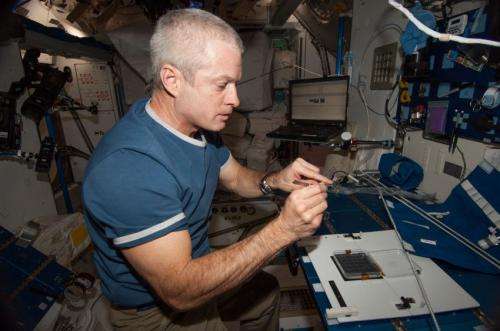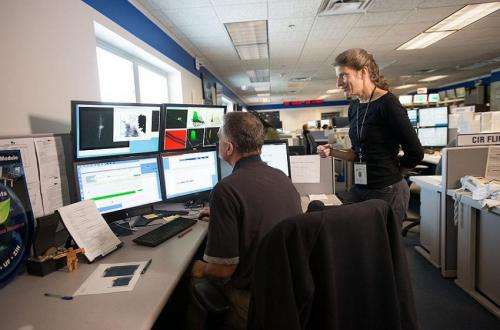Getting to the root of the problem in space

When we go to Mars, will astronauts be able to grow enough food there to maintain a healthy diet? Will they be able to produce food in NASA's Orion spacecraft on the year-long trip to Mars? How about growing food on Earth under extreme conditions? These are questions scientists are trying to answer by observing plant growth in microgravity on the International Space Station (ISS).
Plant biology investigations called Petri Plants explore the fundamental genetic mechanisms plants use to adapt to a microgravity environment. When a crew leaves Earth orbit to go into space, plants can recycle the astronauts' exhaled carbon dioxide and excreted water in addition to providing food. "Plants give us insight into the fundamental nature of higher organisms, so learning about the metabolism of plants in response to a unique and challenging environment also tells us about ourselves," said Anna-Lisa Paul, Ph.D., principal investigator for the study with the University of Florida.
It was originally thought that certain specialized root movements were due to cellular response to gravity pulling on roots as they navigated across a surface. However, early investigations launched to the space station by Paul and her colleague Robert Ferl, Ph.D., University of Florida, showed that the root movements, known as waving and skewing, occurred on the space station in microgravity. The researchers designed Characterizing Arabidopsis Root Attractions (CARA) to investigate the impact of light on root skewing in microgravity and further explore the molecular genetic responses of these plants.
The plant Paul and Ferl are investigating is Arabidopsis thaliana, commonly referred to as Thale Cress. Arabidopsis is an important, well-established model organism for plant research because its genome has been completely sequenced, and it is easy to genetically engineer. The plant has been well characterized in spaceflight environments on both the shuttle and space station.
Paul and Ferl worked with engineers at NASA's Glenn Research Center in Cleveland and ZIN Technologies to adapt the Light Microscopy Module (LMM) for such biological applications. The LMM is a modified commercial, light imaging microscope facility aboard the space station that provides researchers with powerful diagnostic hardware and software. "These experiments also allowed for an increase in use of the LMM that was previously unavailable." said Ron Sicker, project manager at Glenn. "The Petri Plants investigations were conducted on board the space station while SpaceX was docked and the LMM was normally shut down."

For the CARA investigation, the arabidopsis seed was genetically modified with a green-fluorescing protein marker, called GFP. This allowed scientists to see how the plant responded to microgravity. Plants engineered with GFP-tagged genes, referred to as "reporter genes," made it possible to visualize the behavior of these genes in orbit, but only if coupled with the right tool to enable GFP visualization. Access to the LMM allowed the scientists to observe the changes in GFP-tagged genes in the roots on the cellular level using a special filter to observe the fluorescing of the cells. The basic design of the experiment was to compare a series of Petri plates containing arabidopsis seedlings to different lighting conditions on the space station, and then compare those plates to their comparable ground controls. These controls reside in the ISS Environmental Simulator (ISSES) chamber at NASA's Kennedy Space Center in Florida.
The plants were exposed to the diffused light present on the station by attaching the Petri dishes, which included the seeds and a growing medium, directly on an inner wall of the space station. This exposed the plants to the ambient lighting of the space station module in which they were housed. They were then compared to plants grown in Petri dishes wrapped in black cloth that were not exposed to any light. These were also aboard station with their lit companions so all other aspects of the microgravity environment remain the same—isolating the difference made by the light.
Most of the plates of arabidopsis plants were dedicated for harvest, and then molecular analyses on the ground. However, one plate was seeded with plants engineered with GFP reporter genes. This plate was inserted into the LMM for real-time evaluation of gene expression in orbit. Any place a normal gene would be expressed, the behavior of the gene with the marker could be seen with fluorescence microscopy.
The investigation was monitored by Paul and Ferl at Glenn's Telescience Support Center. The microscope was operated remotely from the ground by the scientists conducting the investigation, and images were sent directly from the LMM to the Telescience Support Center.
"We were intrigued by the numerous light-sensing genes that are expressed specifically in roots in orbit, and the CARA experiments explored the role of these genes in orientation and cellular remodeling." Paul said. "In these experiments, we found that light had a very profound impact on not only the direction of root growth but also the morphology or patterns of root growth."

The CARA investigation was sponsored by the Center for the Advancement of Science in Space (CASIS) and supported by NASA. CASIS is responsible for the management of the U.S. national laboratory on the space station.
"We ran the same tests here on Earth as they were running on the space station at the same time, so that a comparison could be made between the plant growth on the space station and the plant growth on Earth." said April Spinale, CASIS payload developer at Kennedy. "CASIS is particularly interested in experiments that will have an Earth benefit. In the case of Petri Plants, the research could lead to plants that could be adapted to grow in challenging environments on Earth, such as areas affected by extreme drought or industrial intrusion," Sicker also emphasized the importance of Petri Plants investigations, "These investigations help us to understand how plants adapt to stresses and changes in the environment."
Paul further commented on the way the information from this study could help on the ground. "A lot of research done previously for space flight or closed system ecologies for advanced life support systems are used for closed environments, such as commercial green houses to make them more efficient, save time, and money."
The team of Paul and Ferl have more arabidopsis investigations scheduled for study aboard the space station. The next studies they plan to do in space are the Advanced Plant Experiments (APEX)-03-1 and -03-2. APEX-03 will explore additional genetic information on how plants respond to microgravity. This growing interest in horticulture in orbit will keep the crew farming for the near future and may make astronaut farmers of the next generation of space explorers.
Provided by NASA





















